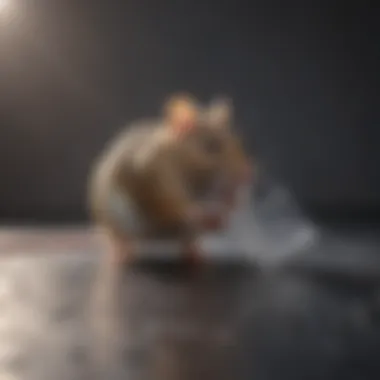The Role of Sticky Traps in Managing Mouse Populations


Intro
Sticky traps have emerged as a prominent tool in the control of mouse populations. The increasing prevalence of these unwanted rodents in urban and suburban areas necessitates innovative strategies. Understanding the nuances of sticky traps extends beyond mere placement; it involves comprehending their design, effectiveness, and potential ethical implications.
This article will cover pivotal topics such as the identification of pests, prevention strategies, and various treatment options. Homeowners and pest control professionals alike can benefit from examining how sticky traps fit into the broader pest management landscape. Through this exploration, readers will gain insights into optimizing their approach to rodent control, ensuring an effective balance between efficiency and ethical considerations.
Pest Identification
Detailed descriptions of common pests
Mice are among the most common pests that invade homes. The two primary species you might encounter are the house mouse and the deer mouse.
The house mouse, with its small body, typically measures 2.5 to 4 inches and has a prominent, pointed snout. Its fur is mostly brown or gray. In contrast, the deer mouse, identifiable by its two-toned coloration, has a white underbelly and is slightly larger, measuring around 3 to 4 inches.
Signs and symptoms of infestations
Detecting an infestation early is crucial for control. Here are some common signs:
- Droppings: Fresh droppings indicate recent activity, while old droppings can signal a longer-term presence.
- Gnaw marks: Mice have strong teeth and will gnaw to gain access to food.
- Nests: Shredded materials like paper or fabric can often be found in hidden areas as nesting material.
Prevention Strategies
Home maintenance tips for pest prevention
Effective prevention is often more efficient than treatment. Consider these strategies:
- Seal entry points: Close off gaps and holes in walls and foundations to deny access.
- Secure food storage: Store food in airtight containers to eliminate attractive food sources.
- Maintain cleanliness: Regularly clean areas, especially kitchens, to reduce the chances of attracting pests.
Natural deterrents and barriers
Certain substances can act as natural deterrents. Consider:
- Peppermint oil: Its strong smell can deter mice. A few drops around entry points can be effective.
- Ultrasonic repellents: These devices emit sounds that are unpleasant to rodents, potentially driving them away.
Treatment Options
Overview of chemical vs. natural treatments
Understanding treatment options is critical when dealing with infestations. Chemical traps often involve toxic substances, presenting risks for pets and children. In contrast, natural treatments might include traps like sticky pads, which can capture live mice without chemicals.
Step-by-step guides for DIY treatments
- Placement of sticky traps: Identify high-traffic areas in your home. Common places include behind appliances and near food sources.
- Baiting the traps: While sticky traps can work unscented, adding small amounts of peanut butter or nuts enhances their effectiveness.
- Regular checks: Check the traps regularly to ensure they are working and to address any captured mice promptly.
The right approach to pest control not only focuses on removing the problem but also on sustainability and ethical considerations.
By applying a comprehensive strategy that includes effective identification, preventive measures, and appropriate treatment options, homeowners can better manage mouse populations, paving the way for a pest-free environment.
Intro to Sticky Traps
The management of mouse populations is a critical concern for homeowners and pest control professionals alike. Sticky traps are one method used to address these issues. Understanding the intricacies of sticky traps is essential to maximize their effectiveness and to comprehend their impact on mouse populations. In this section, we will cover the fundamental aspects of sticky traps, including their definition, purpose, and historical significance. By gaining insights into these elements, readers can make informed decisions regarding their use.
Definition and Purpose
Sticky traps are devices designed to capture rodents through a simple yet effective mechanism. These traps are coated with a strong adhesive that immobilizes mice once they come into contact with the surface. The primary purpose of sticky traps is to provide a means of rodent control, especially in areas where traditional traps may not be practical or effective. They are particularly advantageous in terms of ease of use and deployment.
Homeowners often prefer sticky traps because they do not require bait or special settings—their functionality is straightforward. However, it is essential to recognize these traps also have limitations, such as the potential for prolonged suffering of captured mice, raising ethical considerations when deploying them.


Historical Overview
The historical context of sticky traps can shed light on their evolution and acceptance in pest management strategies. Nagging rodent problems have existed for centuries, compelling humans to seek effective solutions. The origins of sticky traps can be traced back to simple adhesive boards used in agriculture, aimed at controlling insect populations. As time progressed, the application of these principles expanded to address rodent issues.
By the mid-20th century, manufacturers began producing sticky traps explicitly targeting mice and rats. In the U.S. and Europe, sticky traps became increasingly available in stores as an alternative to snap traps and poison. Their rise in popularity corresponded with growing concerns regarding the dangers of rodenticides, which can have severe environmental impacts. People began to recognize sticky traps as a less hazardous option, although the ethical implications continue to be debated in modern pest control discussions.
"Sticky traps offer a straightforward solution for pest control, but it's crucial to consider both their effectiveness and the welfare of captured animals."
Overall, knowing the definition, purpose, and historical significance of sticky traps helps homeowners and pest control experts grasp their role in managing mouse populations effectively.
Design and Functionality of Sticky Traps
The design and functionality of sticky traps play a crucial role in their effectiveness as a pest control tool. Understanding these elements not only helps in maximizing their impact but also informs users about best practices for implementation. Sticky traps are engineered to strategically target mouse populations, making it essential to analyze the materials, mechanics of attraction, and proper placement strategies.
Materials Used
Sticky traps are composed of several materials that contribute to their durability and effectiveness. One common material is a strong adhesive that ensures mice are effectively captured upon contact. This adhesive must maintain its potency over time without drying out.
The base of the trap is typically made from cardboard or plastic, providing a sturdy platform. Some traps incorporate bait stations to lure mice more effectively. The combination of high-quality adhesive and durable backing materials is essential for operational efficiency. Additionally, it is vital that these materials do not pose harm to pets or children.
Environmental factors also influence material choice. For instance, traps meant for indoor use might be designed with aesthetic considerations. In contrast, those for outdoor environments prioritize resilience against weather conditions.
Mechanics of Attraction
The mechanics of attraction are pivotal in determining how effectively sticky traps catch mice. Mice are naturally curious animals, which should be exploited to enhance capture rates. Commonly, traps utilize specific scents to entice mice. These might include peanut butter or other food substances that are appealing to them.
Sound can also be an attractive factor. Traps that create an occasional noise may pique a mouse's interest, leading them closer. Furthermore, the color of the trap can influence its visibility to mice, as certain hues may be more appealing in specific settings. Combining these elements—scent, sound, and color—can dramatically increase the likelihood of successful captures.
Placement Strategies
Placement strategies are integral to the success of sticky traps in controlling mouse populations. First, identifying high-traffic areas is crucial; these locations often include near walls or corners where mice tend to travel. Traps should be placed parallel to these paths, rather than perpendicular, to maximize encounters.
The optimal number of traps depends on the severity of the infestation. In cases of significant mouse presence, deploying multiple traps can be more effective. Regular repositioning is also advised; mice may alter their routes based on environmental cues or changes in the traps’ presence.
Here are some best practices for placement:
- Avoid human interaction: Place traps away from areas with high foot traffic.
- Utilize nesting sites: Target areas like storage spaces or behind appliances.
- Maintain cleanliness: Make sure to eliminate food sources that might reduce trap effectiveness.
Efficacy of Sticky Traps
Understanding the efficacy of sticky traps is critical in evaluating their role in controlling mouse populations. These traps offer a specific method for catching rodents, making them an integral part of various pest management strategies. Factors such as catch rates, limitations, and comparative effectiveness against other traps are essential in forming a complete picture of how these devices work in practice. This section analyzes these aspects and highlights the significance of sticky traps in pest control.
Effectiveness in Catch Rates
Sticky traps are designed to capture mice effectively when placed in areas with high rodent activity. The effectiveness can be quantified through several metrics, primarily catch rates which refer specific number of captures over a defined period. Research indicates that when positioned correctly, sticky traps can achieve catch rates that are comparable to more traditional trapping methods.
Conditions such as placement near nesting sites and food sources are vital for improving catch rates. Studies have shown that catch rates can vary significantly based on these factors. Ensuring that the traps are maintained and inspected regularly enhances their performance. This consistency is crucial for maintaining high success rates in capturing mice.
Limitations of Use
Despite their effectiveness, sticky traps do have limitations. One primary concern is the potential for non-target animals to become ensnared. This can lead to ethical dilemmas as it poses threats to other wildlife, domesticated pets, or beneficial insects. The despairing situation of a trapped mouse can also evoke feelings of unease for homeowners.
Furthermore, sticky traps can become less effective in extreme weather conditions. For example, exposure to moisture can degrade the adhesive properties of the traps, resulting in lower catch rates. Additionally, the physical size and design of the trap can restrict the types of mice that are captured, which may limit their overall utility for certain settings.
Comparison with Other Traps


When evaluating sticky traps against other trapping options, several distinctions arise. Traditional snap traps, for instance, often provide quicker kill times but may require a certain level of skill to set properly. In contrast, the sticky traps require less technical knowledge, making them more user-friendly for the average homeowner.
To summarize, sticky traps offer a reliable method of capturing mice but are not devoid of challenges. They may sometimes be less effective in comparison to snap traps regarding speed of capture, yet they excel in ease of use. Homeowners must assess which type of trap aligns best with their specific needs, considering both efficacy and ethical implications in their decision-making process.
"Effective pest control depends on understanding both the functionality and implications of each method. Sticky traps are a valuable tool, but are best used in conjunction with a comprehensive pest control plan."
The analysis of the efficacy of sticky traps reveals the contours of effective rodent management. Recognizing both their strengths and limitations is essential for suitable pest management.
Ethical Considerations in Using Sticky Traps
As discussions around mouse control evolve, it’s crucial to address the ethical considerations surrounding the use of sticky traps. This aspect is not just about the effectiveness of the traps, but also about how they align with contemporary standards of animal welfare and regulatory requirements. Evaluating the implications of using sticky traps can help homeowners and professionals make informed decisions about rodent control methods that respect both efficacy and ethicality.
Animal Welfare Concerns
The primary ethical concern about sticky traps involves animal welfare. Sticky traps capture mice and other small rodents by immobilizing them against a sticky surface. This can lead to prolonged distress as the trapped animals struggle to escape. In some cases, trapped mice can suffer from dehydration, starvation, or exposure. Critics argue that such suffering is unnecessary and can often be avoided through more humane methods.
Advocates for animal welfare emphasize the importance of using traps that minimize suffering. They remind us that effective rodent control should not come at the cost of compassion. Alternatives such as snap traps or catch-and-release traps are highlighted as more humane options. A balanced approach would consider both the effectiveness of controlling mouse populations while ensuring humane treatment.
Regulatory Frameworks
The use of sticky traps is also governed by various regulatory frameworks, which vary by region. Some jurisdictions impose strict guidelines on how these traps can be used, particularly in residential areas. The intention behind these regulations is to ensure that pest control methods adhere to animal welfare standards.
For example, regulatory bodies may specify the types of traps that homeowners can legally use or mandate certain practices to reduce animal suffering. Awareness of these regulations is essential to ensure compliance and to align pest management strategies with ethical considerations. Not only does this show a commitment to humane practices, but it also helps mitigate potential legal ramifications for homeowners and pest control professionals.
"Success in pest management is not just measured in numbers but also in the ethical implications of the methods employed."
The interplay of animal welfare concerns and regulatory frameworks raises important questions about the use of sticky traps. As society becomes increasingly aware of animal rights issues, the demand for ethical practices in pest control is likely to grow. Therefore, understanding these considerations can lead to better practices that meet both efficacy goals and moral standards.
Practical Applications of Sticky Traps for Rodent Control
Sticky traps have gained significant attention in the realm of rodent control due to their straightforward design and ease of use. Their practical applications extend beyond mere catching of mice, as they play a critical role in integrated pest management strategies. Understanding these applications is essential for homeowners and pest control professionals alike.
Home Use Scenarios
In residential settings, sticky traps are often favored for their simplicity. Homeowners can place them in strategic locations where mouse activity is suspected, such as along walls, behind appliances, or near food storage areas. The traps can catch rodents effectively without the need for complicated setup or handling of bait.
Notably, sticky traps can be utilized in different stages of a rodent infestation. In the initial phases, they can help in monitoring mouse populations, offering insights on the extent of the problem. Through regular checks, homeowners can adjust their strategies based on the catch rates observed. This approach allows for minimal disruption to daily life while maintaining effective control over rodent populations.
Commercial Use Cases
For businesses, the application of sticky traps can be critical. Restaurants, food processing facilities, and warehouses often face stringent health regulations regarding pest control. Using sticky traps in these environments can assist in maintaining compliance with these regulations.
In commercial settings, specific considerations arise. Regular monitoring of trap effectiveness can help identify high infestation zones. Additionally, integrating these traps into a broader pest management plan can prevent future infestations. Many businesses find that combining sticky traps with other control methods enhances overall effectiveness while keeping disturbances low.
Integrating with Comprehensive Pest Management
To maximize their benefits, sticky traps should not be used in isolation. Integrating sticky traps with comprehensive pest management strategies proves to be a highly effective approach. This may include preventive measures such as sealing entry points, maintaining cleanliness, and regular inspections.
A balanced strategy may incorporate:
- Physical Barriers: Ensuring doors and windows are sealed to prevent entry.
- Sanitation Procedures: Regular cleaning to eliminate food sources for rodents.
- Monitoring Systems: Frequent assessments of traps to gauge activity levels and adjust methods accordingly.
Not all pest control methods are equally effective. A comprehensive plan is crucial for long-term management of rodent populations.
Alternatives to Sticky Traps


When dealing with mouse populations, sticky traps are one option among many. Understanding alternatives to these traps is crucial for homeowners and pest control professionals. Each alternative brings its own merits and challenges. Moreover, it influences not just the effectiveness of rodent control but also impacts ethical considerations and the environment.
Humane Trapping Methods
Humane trapping methods focus on capturing rodents alive for later release. These methods include live animal traps. Live traps are designed to ensnare mice without causing injury. This approach appeals to those who prioritize animal welfare. Users must remember, however, that releasing captured mice in unfamiliar areas can lead to survival issues for them. Also, one must adhere to local regulations regarding animal release.
Key Advantages of Humane Trapping:
- Animal Welfare: Reduces harm to captured mice.
- Ethical Considerations: Aligns with values of compassion.
- Reusability: Many traps can be used multiple times, making them cost-effective.
Chemical Alternatives
Chemical alternatives, such as rodenticides, are another option for controlling mouse populations. Various poisons exist, but they raise significant concerns. For example, accidental ingestion by pets or non-target wildlife is a risk. Furthermore, the effects on the garbage ecosystem must be considered. Users need to follow safety instructions rigorously.
Considerations When Using Chemical Alternatives:
- Effectiveness: Fast-acting solutions can quickly reduce populations.
- Safety Risks: Careful storage and usage are mandatory to prevent accidents.
- Environmental Impact: Consider long-term effects on local wildlife and ecosystems.
Natural Deterrents
Natural deterrents use non-toxic substances to prevent mice from entering specific areas. For instance, certain essential oils, such as peppermint or eucalyptus, are found to repel rodents. Other deterrents include mixtures of vinegar or cayenne pepper. These methods do not necessarily eliminate mice but can effectively reduce their presence. Such techniques are ideal for households with children or pets.
Benefits of Natural Deterrents:
- Non-toxic: Safe for family and pets.
- Easy to Apply: Many deterrents can be used with minimal effort.
- Interest in Sustainability: Aligns with growing trends toward eco-friendly pest management.
Case Studies and Real-Life Examples
Successful Implementations
Several documented cases illustrate successful implementations of sticky traps in various settings. For instance, a study conducted in an agricultural setting showed that farmers effectively reduced mouse populations by using sticky traps strategically placed near grain storage. The traps captured a significant number of mice, leading to a noticeable decrease in crop damages. This success stemmed from the correct placement of traps, which was guided by the understanding of mouse behavior and movement patterns.
Another successful instance comes from urban residential areas, where homeowners reported positive outcomes after deploying sticky traps in attics and basements. One homeowner noted that after placing the traps in corners and near entry points, they managed to capture multiple mice within a few days. The ease of monitoring the traps also contributed to their effectiveness, allowing immediate response once a mouse was trapped.
These examples demonstrate the potential of sticky traps when used thoughtfully. They also emphasize the importance of educating users on proper techniques, placement, and maintenance of the traps for optimal performance.
Challenges Faced
Despite several successful implementations, challenges still arise when using sticky traps. One of the most significant issues reported is the potential for non-target captures. In some instances, birds or small pets can unintentionally get caught in the traps, raising concerns about animal welfare. This issue necessitates careful consideration of trap placement to avoid such accidents.
Moreover, sticky traps have limitations related to their effectiveness in high infestation scenarios. In cases where mouse populations are extreme, these traps might not suffice on their own. Users often require a comprehensive pest management strategy that combines traps with other methods like baiting or exclusion.
Environmental factors can also pose challenges. For example, excessive humidity or high temperatures can reduce the adhesion of traps, leading to fewer captures. Some real-life users have reported needing to replace traps frequently due to weather conditions affecting performance.
Ending
Understanding the role of sticky traps in managing mouse populations extends beyond mere rodent control; it encompasses various ethical, practical, and regulatory considerations. As households grapple with pest issues, finding a balance between effectiveness and humane treatment becomes paramount. This article has assessed the dynamics of sticky traps, revealing both their strengths and weaknesses in the realm of pest management.
Summary of Findings
The analysis of sticky traps reveals important insights regarding their design, functionality, and applicability in different contexts. Key findings include:
- Effective Catch Rates: Sticky traps can achieve significant catch rates when placed in strategic locations, highlighting the importance of placement strategies.
- Animal Welfare: Ethical considerations are crucial, as the welfare of trapped mice must be taken into account. Regulatory frameworks may influence the choice and usage of these traps, suggesting a need for compliance and awareness among users.
- Limitations: While sticky traps serve as a useful tool, their limitations are noteworthy. They do not discriminate between targeted and non-targeted species, raising concerns about unintended captures.
- Integration with Other Methods: The best pest management practices often involve a combination of methods. Sticky traps can complement other pest control strategies, offering a more robust approach to managing mouse populations.
Future of Sticky Traps in Pest Control
The future landscape of pest control may be shaped by advancements in trap design, technology, and public perception of humane treatment. The continued refinement of sticky trap materials and mechanisms could increase their efficacy and reduce animal suffering. Moreover, integrating sticky traps into a holistic pest management strategy remains a promising avenue.
Research and development will likely pave the way for more humane and effective trapping solutions. Stakeholders in pest control—ranging from homeowners to pest management professionals—must stay informed about innovations and ethical standards. This could potentially influence market trends and consumer preferences.
Understanding the complexities of pest management is crucial for effective and ethical rodent control.



